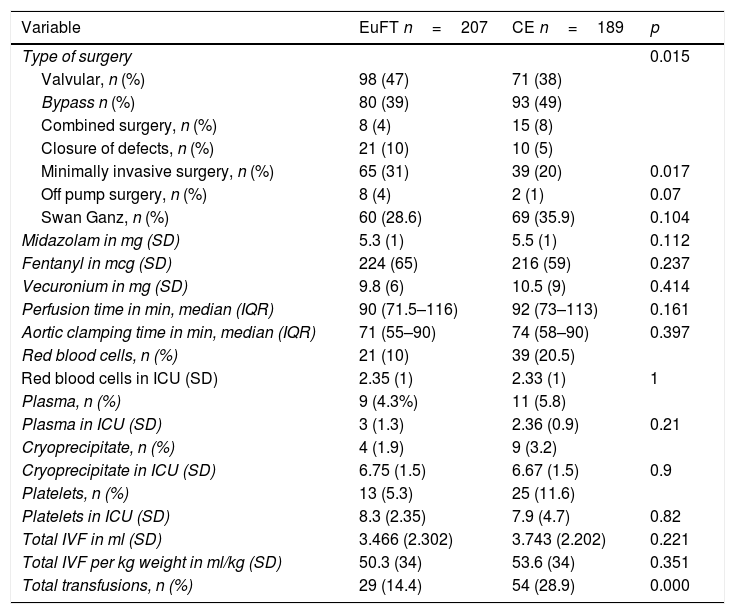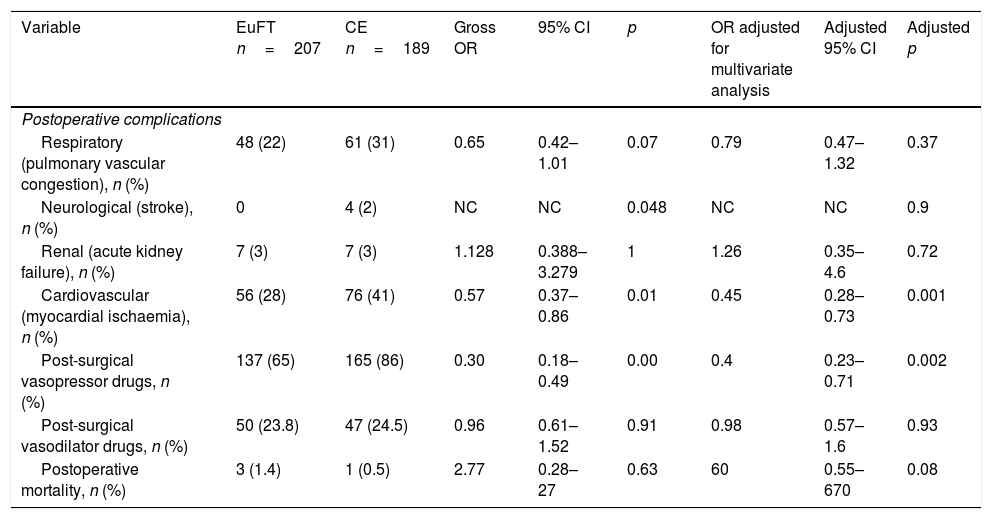The fast track/ultra-fast-track protocols are techniques used to optimise the patient care process and a quick recovery after cardiac surgery. They are one of the mainstays of efficient practice. With their use, the length of hospital and intensive care unit (ICU) stays are reduced, with a direct impact on costs and the quality of the health service.
ObjectiveTo compare the length of stay in the ICU, length of hospital stay, and post-operative mortality in ultra-fast-track extubated (uFTE) patients and those with conventional extubation (CE) after cardiac surgery.
MethodsLongitudinal, analytical, retrospective study was conducted, with the period between the time of surgery and discharge being included as the study period.
ResultsA total of 396 patients older than 18 years who required cardiac surgery were included, of whom 207 patients had (uFTE) and 189 had CE. Although the groups were not comparable due to the statistical differences found, when performing the multivariate adjustment, uFTE maintained its statistical independence and was associated with lower cardiovascular morbidity, such as myocardial ischaemia (95% CI: 0.37–0.86; p=0.01) and lower post-surgical vasopressor requirement (95% CI: 0.18–0.49; p<0.01). No significant differences were found in the length of hospital stay, ICU stay, or post-operative mortality in the ICU.
Conclusi¢nImplementing the uFTE strategy, decreases cardiovascular morbidity and vasopressor requirement. The change to uFTE should be accompanied by changes in models and practices in patient recovery to standardised protocols. This study shows that uFTE did not reduce the length of ICU stay, hospital stay, or mortality.
Los protocolos fast track y ultra fast-track son técnicas que permiten la optimización del proceso de atención del paciente y una rápida recuperación tras cirugía cardiaca. Actualmente se considera que la extubación temprana es un pilar de la práctica eficiente, en la medida en que con su uso se ha descrito una reducción en los tiempos de estancias hospitalaria y en la unidad de cuidados intensivos (UCI), con un impacto directo en los costos y en la calidad del servicio de salud.
ObjetivoComparar los tiempos de estancia en UCI, tiempo de estancia hospitalaria y mortalidad postoperatoria en pacientes con extubación ultra fast-track (EuFT) y en aquellos con extubación convencional (EC) tras cirugía cardiaca.
MétodosEstudio longitudinal, analítico, retrospectivo. Se incluyó como período de estudio el comprendido entre el momento de la cirugía y el alta hospitalaria.
ResultadosSe incluyó a un total de 396 pacientes mayores de 18 años que requirieron cirugía cardiaca. De ellos, 207 pacientes tuvieron EuFT y 189, EC. A pesar de que los grupos no fueron comparables debido a las diferencias estadísticas encontradas, al realizar el ajuste multivariado, la EuFT mantuvo su independencia estadística y estuvo asociada a menor morbilidad cardiovascular, como isquemia miocárdica (IC 95%: 0,37-0,86; p = 0,01) y menor requerimiento de vasopresor posquirúrgico (IC 95%: 0,18-0,49; p < 0,01). No se encontraron diferencias significativas en los tiempos de estancia hospitalaria, estancia en UCI ni mortalidad postoperatoria en UCI.
ConclusiónImplementando la estrategia EuFT, disminuye la morbilidad cardiovascular y el requerimiento vasopresor. El cambio a EuFT debe ser acompañado por cambios en modelos y prácticas de recuperación de los pacientes, como protocolos estandarizados. Por lo anterior, con este estudio se demuestra que en los pacientes con EuFT no disminuyen los tiempos de estancia en UCI, estancia hospitalaria ni mortalidad.
Artículo
Comprando el artículo el PDF del mismo podrá ser descargado
Precio 19,34 €
Comprar ahora










